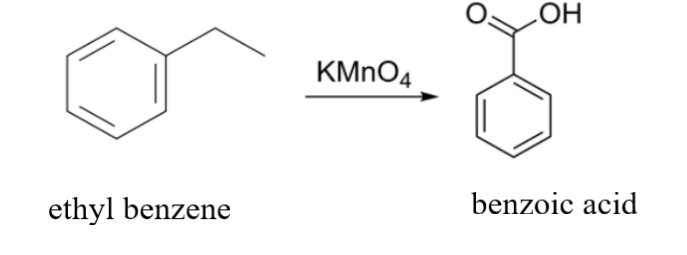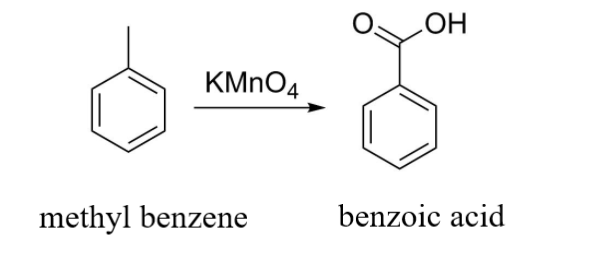
The compound formed as a result of oxidation of ethylbenzene by
A. acetophenone
B. benzophenone
C. benzoic acid
D. benzaldehyde
Answer
497.1k+ views
Hint: Any aliphatic carbon with hydrogen attached to it, in combination with a benzene ring will be oxidized to benzoic acid regardless of the length of the entire side chain as
Complete step by step answer:
Here, we are provided with ethyl benzene i.e.
The reaction is as follows:

Another example can be:

In this example, the result of oxidation of methyl benzene with
From the above two cases, we infer that the reaction does not depend on the length of the side chain attached to the benzene ring. Irrespective of the side chain, the
Hence option (C) is correct.
Note:
Keep in mind the trick that no matter how long the side chain is, the result of this reaction will always be benzoic acid as explained above that the reaction does not depend on the length of the side chain attached to the ring.
Complete step by step answer:
Here, we are provided with ethyl benzene i.e.
The reaction is as follows:

Another example can be:

In this example, the result of oxidation of methyl benzene with
From the above two cases, we infer that the reaction does not depend on the length of the side chain attached to the benzene ring. Irrespective of the side chain, the
Hence option (C) is correct.
Note:
Keep in mind the trick that no matter how long the side chain is, the result of this reaction will always be benzoic acid as explained above that the reaction does not depend on the length of the side chain attached to the ring.
Latest Vedantu courses for you
Grade 11 Science PCM | CBSE | SCHOOL | English
CBSE (2025-26)
School Full course for CBSE students
₹41,848 per year
Recently Updated Pages
Master Class 4 Maths: Engaging Questions & Answers for Success

Master Class 4 English: Engaging Questions & Answers for Success

Master Class 4 Science: Engaging Questions & Answers for Success

Class 4 Question and Answer - Your Ultimate Solutions Guide

Master Class 11 Economics: Engaging Questions & Answers for Success

Master Class 11 Business Studies: Engaging Questions & Answers for Success

Trending doubts
Give 10 examples of unisexual and bisexual flowers

Draw a labelled sketch of the human eye class 12 physics CBSE

a Tabulate the differences in the characteristics of class 12 chemistry CBSE

Differentiate between homogeneous and heterogeneous class 12 chemistry CBSE

Why is the cell called the structural and functional class 12 biology CBSE

Differentiate between insitu conservation and exsitu class 12 biology CBSE




